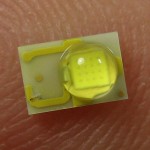
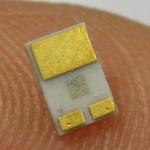 I got three of these 3 W Luxeon Rebel cool white LEDs from SparkFun as possible sources of the flash in the RF starter’s gun replacement project. I’ll run them at close to the 1A absolute max current, for maybe 10 or 20 ms. The big pad is just for heat sink. Operating current is through the 2 small pads.
I got three of these 3 W Luxeon Rebel cool white LEDs from SparkFun as possible sources of the flash in the RF starter’s gun replacement project. I’ll run them at close to the 1A absolute max current, for maybe 10 or 20 ms. The big pad is just for heat sink. Operating current is through the 2 small pads.
Making a holder for them was pretty pleasant. While the Eagle footprint from SparkFun said “for any Luxeon LED”, it clearly wouldn’t work for these. But there was a footprint in the led-lumiled library that looked good. While the design current is very high, duration – and thus power dissipation – is low, so I didn’t worry much about heat sinking. I did still provide some copper for that pad, though.
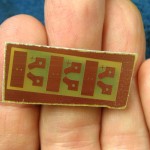 The PCB with 3 layouts of the mount was so small I could put it on an otherwise unusably small scrap of PCB material, and I’m still using my regenerable cupric chloride etchant, so they were essentially free. I like that.
The PCB with 3 layouts of the mount was so small I could put it on an otherwise unusably small scrap of PCB material, and I’m still using my regenerable cupric chloride etchant, so they were essentially free. I like that.
As expected, it’s very bright, and I haven’t even run it above 60 mA or so. I haven’t put together a good current limited pulse supply yet, but it will be interesting to see what it  does as a flash near 1A! Here is it at about 0.1 mA.
does as a flash near 1A! Here is it at about 0.1 mA.
There are two options for the optics. It’s vaguely possible that it will just be aimed in the general direction of the runners. From the datasheet, the half-power cone is ~120°, so aiming wouldn’t be very fussy.
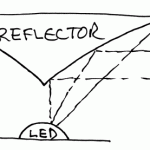 The more likely arrangement would attempt a horizontally omnidirectional distribution, with a fairly narrow dispersion vertically. All the targets of interest (runners, other officials, timing system optical sensors) would be within a few degrees vertically of the LED at the distances they would typically be from the flash. Inspired by some landscaping lights I’ve seen consisting of a maybe 8″ diameter post in the ground, 4′ tall, with the top 8″ a clear cylinder housing an upward-shining light with a sort of conical reflector – point down, with a concave curved cross section (it’s hard to describe!) providing an omnidirectional downwash of light, my first attempt will be a small (~0.6″ diam?), short (~0.25″?) conical reflector possibly turned out of aluminum, well polished. About the only science I can offer for the actual cross section will be hand sketched ray diagrams. Looks like the point of the cone facing the LED should have an included angle around 90° so light originating vertically would be reflected straight out. Should be interesting.
The more likely arrangement would attempt a horizontally omnidirectional distribution, with a fairly narrow dispersion vertically. All the targets of interest (runners, other officials, timing system optical sensors) would be within a few degrees vertically of the LED at the distances they would typically be from the flash. Inspired by some landscaping lights I’ve seen consisting of a maybe 8″ diameter post in the ground, 4′ tall, with the top 8″ a clear cylinder housing an upward-shining light with a sort of conical reflector – point down, with a concave curved cross section (it’s hard to describe!) providing an omnidirectional downwash of light, my first attempt will be a small (~0.6″ diam?), short (~0.25″?) conical reflector possibly turned out of aluminum, well polished. About the only science I can offer for the actual cross section will be hand sketched ray diagrams. Looks like the point of the cone facing the LED should have an included angle around 90° so light originating vertically would be reflected straight out. Should be interesting.
Update 12/5/11: Posted a “how do I make this” question in the Workshop88 chat room for the reflector. Got lots of interesting suggestions. Was inspired to try 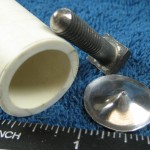 stretching some thin aluminum sheet, and it worked out pretty well. Using a bit of 3/4″ PVC pipe as a die and a bolt hand ground (not turned) to a ~90° point and the very point rounded a bit, I got a pretty reasonable shape. I used a sharper pointed punch at the very end to do the very center. A little metal polish and it looks about like what I think is needed. Here’s a little clip of it. The flat edge needs to be trimmed, and of course some sort of mounting provided with adjustable distance from the LED to “focus” it. Watching the shape of the band of light (I hope to see) on the wall in a darkened room as that adjustment is made will be interesting.
stretching some thin aluminum sheet, and it worked out pretty well. Using a bit of 3/4″ PVC pipe as a die and a bolt hand ground (not turned) to a ~90° point and the very point rounded a bit, I got a pretty reasonable shape. I used a sharper pointed punch at the very end to do the very center. A little metal polish and it looks about like what I think is needed. Here’s a little clip of it. The flat edge needs to be trimmed, and of course some sort of mounting provided with adjustable distance from the LED to “focus” it. Watching the shape of the band of light (I hope to see) on the wall in a darkened room as that adjustment is made will be interesting.
The reflector’s size makes it easily printable on the Makerbot. I created a model 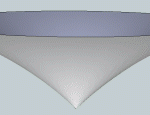 in Sketchup, but haven’t taken it any closer to Gcode than that. Of course the Makerbot’s resolution isn’t nearly good enough for a mirror finish, so either smoothing with acetone or filling with epoxy or plaster or Bondo or something and sanding smooth and polishing would be required. Possible silvering methods include painting with conductive paint and electroplating it and painting with chrome spray paint. I haven’t tried the latter, but the results on videos on YouTube look pretty good 🙂
in Sketchup, but haven’t taken it any closer to Gcode than that. Of course the Makerbot’s resolution isn’t nearly good enough for a mirror finish, so either smoothing with acetone or filling with epoxy or plaster or Bondo or something and sanding smooth and polishing would be required. Possible silvering methods include painting with conductive paint and electroplating it and painting with chrome spray paint. I haven’t tried the latter, but the results on videos on YouTube look pretty good 🙂

Pingback: RF starter’s gun | Jim's Projects
I bought a bunch of bright red LEDs from Evil Mad Science. They were intended for traffic lights and have a 30 degree beam angle. I had real good luck broadening that angle by just grinding the rounded lens flat. Sanded the resulting blunt end up to about 400 grit and polished with a scrap of MDF.
I’ve ground the tops off various LED lenses to broaden the beam – works well. Polishing with a scrap of MDF is an interesting idea – I’ll have to keep that in mind.
The problem here is that I don’t need _any_ light coming out the top – it all needs to go to the sides. A reflector seems appropriate. A quick initial test indicates this one isn’t quite good enough – both too irregular and not ideal shape. If I knew the shape, I could make a tool and turn something out of aluminum or plastic. If I used plastic, I’m curious whether spray chrome paint would be good enough.
Another approach might be 3 LEDs all looking sideways. At ~120° each, they would cover all directions, though a lot of light would be wasted going up and down from the needed horizontal. (4 would overlap even better.) And more LEDs might give enough more brightness to make it work better (at cost of money and current). Maybe some kind of ring shaped lens – like a donut with the center drilled out to make a cylindrical inside surface – could be used to redirect some of that wasted light.